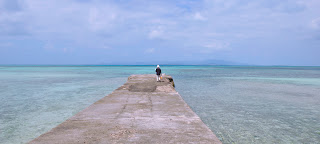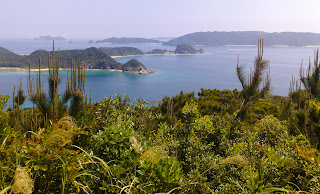After that, I wandered around the city some more and found that there are very nice cherry blossom vistas in Hiroshima, too:
The next day, I took a ferry to Miyajima island. The most famous attraction there is Itsukushima shrine that seems to be floating in the water during high tide.
When I got there, the tide was already on its way out, so I got a good look at how this floating is accomplished:
Apparently, the date of my visit coincided with a festival held at the shrine. As far as I could tell, the main part of the festival was that there were Noh plays being held on the floating stage in the shrine.
 |
| Noh play on the floating stage in Itsukushima shrine |
My next stop was the Buddhist temple Daisho-in. The temple had a very nice atmosphere, consisting of several buildings on a hillside. In one part of its garden, they have collected numerous small Buddha status - one from each of the 88 temples in the Shikoku pilgrimage.
Right next to the temple entrance, there is the beginning of one of the three paths leading up Mt. Misen. It takes a little less than 90 minutes to walk to the top at 535 meters above sea level. The reward? Stunning views of Hiroshima and the islands surrounding Miyajima! Though, admittedly, it would have been even more stunning if it hadn't been a little foggy. But still, I enjoyed the view a lot :-)
For the way down, I chose the lazy option: there is a ropeway leading up the mountain that removes about three quarters of the hike. Near the ropeway station, I found these signs:
Apparently, they have a few problems with monkey-tourist interaction. I didn't see any monkeys, however (and not that many tourists, either).
Before going back to Osaka on the next day, I had enough time to pay a visit to the lovely Shukkeien garden. Very beautiful cherry blossoms (and tons of other flowers, too).
 |
| Shukkeien garden |
On the way to the garden, I noticed some people staring into the sky... so I turned to see if there was anything interesting - and there was:
 |
| Great halo around the sun |





















































